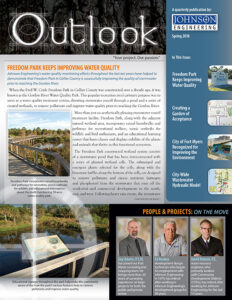 In 2016, Johnson Engineering worked with the City of Naples to develop and calibrate a city-wide model of the wastewater pumping station and force main system. The hydraulic model included 123 pump stations and 310,000 feet of 2-inch to 42-inch diameter pipes as identified from geographic information system (GIS) data provided by the City. The model utilizes extended period simulation that includes 24 hours of average-day conditions and 24 hours of peak-day conditions that occur during wet weather. Extended period simulation allows real-world system behavior to be modeled and interactions between various facilities to be studied. This provides greater insight into operations compared to a static analysis.
In 2016, Johnson Engineering worked with the City of Naples to develop and calibrate a city-wide model of the wastewater pumping station and force main system. The hydraulic model included 123 pump stations and 310,000 feet of 2-inch to 42-inch diameter pipes as identified from geographic information system (GIS) data provided by the City. The model utilizes extended period simulation that includes 24 hours of average-day conditions and 24 hours of peak-day conditions that occur during wet weather. Extended period simulation allows real-world system behavior to be modeled and interactions between various facilities to be studied. This provides greater insight into operations compared to a static analysis.
Using timestamped supervisory control and data acquisition (SCADA) data provided by the City, individual diurnal wastewater flow patterns were developed for 122 existing pump stations. The extensive SCADA data provided by the City were analyzed using software developed in-house. Average-day and peak-day diurnal flow patterns specific to each pump station were integrated into the model. Combined with pump float settings and wetwell dimensions, the model enables true system behavior to be simulated. Modeled flow to the wastewater treatment plant (WWTP) totals 4.8 million gallons per day (MGD) for the average-day period and 7.6 MGD for the peak-day period. Good calibration with observed conditions was obtained, with 98 lift stations calibrated to within plus or minus 6% of the pumping rates calculated from SCADA data.
This project included using the hydraulic model to make recommendations for priority improvements. These recommendations included pump upgrades at two stations and upsizing approximately 9,000 feet of force main. Recommendations for enhancement improvements that improve system reliability were also made. These recommendations included identifying areas for stormwater inflow and infiltration remediation and providing alternative flow routing for a large master pump station.
Municipalities and service providers continue to integrate data collection capabilities and make their wastewater systems smarter. These efforts can be leveraged to develop robust hydraulic models and extended period simulations that provide insight into transient system behavior. These tools are useful for proactively identifying issues, making coordinated system upgrades, and developing focused capital improvement programs.
For more information, contact Michael Dickey, P.E. at 239.334.0046 or [email protected].
































































